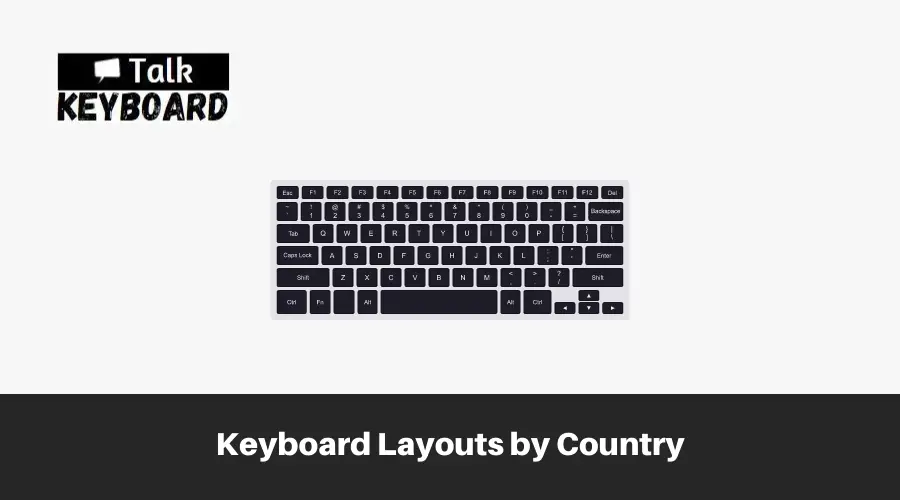Keyboard layouts vary across countries and regions, reflecting diverse linguistic and typographic needs of different cultures. Each country may adopt a keyboard layout tailored to its language and writing system.
From the widely used QWERTY layout in English-speaking countries to the AZERTY layout in French-speaking regions, these variations accommodate language-specific characters and symbols. Other notable layouts include QWERTZ, used in Germany and neighboring countries, and JIS, developed for typing in Japanese.
Understanding keyboard layouts by country is essential for efficient and accurate typing, enabling individuals to communicate effectively and express themselves in their native languages.

Why are there different Keyboard Layouts by Country?
Keyboard layouts vary across different countries due to language-specific needs and historical factors.
- Language Considerations: Different languages require specific characters and symbols that may not exist in other languages.
- Historical Factors: Historical typewriter designs influenced early keyboard layouts, leading to variations in different regions.
- Cultural and Regional Preferences: Certain countries have unique keyboard layouts based on cultural and regional preferences, such as the QWERTZ layout in Germany.
What are the Keyboard Layouts by Country?
Here is a table showcasing some standard keyboard layouts by country:
| Sl# | Keyboard Layout Name | Countries |
| 1 | QWERTY | USA, Canada, UK, Australia, India, Philippines |
| 2 | QWERTZ | Germany, Austria, Switzerland |
| 3 | AZERTY | France, Belgium, Luxembourg |
| 4 | QWERTZU | Czech Republic, Slovakia |
| 5 | JIS | Japan |
| 6 | Dvorak | USA, Canada |
| 7 | Colemak | USA, Canada |
| 8 | Hangul | South Korea |
| 9 | JCUKEN | Russia |
QWERTY
Invented in the 1860s by Christopher Sholes, QWERTY is named after the first six letters in the top row. It provides a familiar layout but may need to be more efficient due to hand movement.
Pros: Familiarity, widely used, easily accessible on most devices.
Cons: Potential inefficiency due to finger movement, higher risk of repetitive strain injuries.
QWERTZ
Developed as a variation of QWERTY for German typewriters, QWERTZ replaces “Y” with “Z” in the top row. It supports German language characters but can be challenging for international users.
Pros: Accommodates German language characters, some similarities to QWERTY layout.
Cons: It may not be suitable for international users and potentially inefficient for non-German languages.
AZERTY
Introduced for French typewriters in the late 19th century, AZERTY is named after the first six letters in the top row. It facilitates French language characters but may need help for non-French speakers.
Pros: Supports French language characters, widely used in French-speaking regions.
Cons: Non-intuitive for non-French speakers, potential inefficiency for other languages.
QWERTZU
An adaptation of QWERTY for Czech and Slovak languages, QWERTZU adds “U” after “Z” in the top row. It accommodates Czech and Slovak language characters but may need to be more intuitive for non-native speakers.
Pros: Accommodates Czech and Slovak language characters.
Cons: Less intuitive for non-native speakers, potential inefficiency for other languages.
JIS (Japanese Industrial Standard)
Developed in Japan for typewriters and computers, JIS supports Japanese characters, symbols, and kana syllables. It is designed for efficient Japanese input but may need help for international users.
Pros: Designed for efficient Japanese input, includes kana syllables and symbols.
Cons: Challenging for non-Japanese users, may require additional input methods for other languages.
Dvorak
Invented in the 1930s by Dr. August Dvorak and his team, Dvorak aims to increase typing speed and reduce finger movement. It offers potential ergonomic benefits but requires adaptation and relearning.
Pros: Designed for increased typing speed and reduced finger movement, with potential ergonomic benefits.
Cons: Requires adaptation and relearning, only sometimes supported on all devices.
Colemak
Introduced in 2006 as an improvement over QWERTY, Colemak retains familiarity while optimizing finger movements. It aims to increase typing efficiency and reduce strain on the fingers.
Pros: Retains familiarity with QWERTY while optimizing finger movements and potential typing efficiency.
Cons: Requires adaptation and relearning, less widely supported than QWERTY.
Hangul
Developed for the Korean alphabet, Hangul is designed explicitly for typing Korean characters. It enables efficient Korean input but may be challenging for non-Korean users.
Pros: Specifically designed for efficient typing of Korean characters.
Cons: Challenging for non-Korean users, potential inefficiency for other languages.
JCUKEN
Used in Russia, JCUKEN is based on the Russian Cyrillic alphabet. It represents the first six letters in the top row, replacing “Y” with “E.” JCUKEN facilitates typing in Russian but may not be ideal for non-Russian speakers.
Pros: Facilitates typing in Russian and supports the Russian Cyrillic alphabet.
Cons: Not suitable for non-Russian speakers, potential inefficiency for other languages.
Different keyboard layouts around the world are explained!
How to Find the Best Keyboard Layout for Your Needs?
Finding the Best Keyboard Layout for Your Needs is crucial. Here are a few tips to follow.
Assess Your Typing Habits and Language Requirements
Consider the languages you frequently type in and the specific characters or symbols you need. Reflect on your typing speed, accuracy, and any discomfort or strain experienced with your current layout.
Research and Compare Layouts
- Explore the available keyboard layouts and their characteristics.
- Look into the pros and cons of each layout, considering factors like efficiency, ergonomics, and language support.
- Read reviews and gather insights from users who have tried different layouts.
Consider Ergonomic Factors and Efficiency
Assess the ergonomic features of each layout, such as finger movement and hand positioning. Determine if a particular layout offers potential efficiency gains based on your typing style.
Experiment with Online Tools or Software
Use online typing tools or software to test different layouts virtually. Familiarize yourself with the feel and comfort of each layout during the experimentation phase.
Seek Feedback from Experienced Users or Communities
Engage with experienced users or join communities where discussions about keyboard layouts take place. Seek advice and opinions to gain insights from others who have already explored different layouts.
Prioritize Comfort, Productivity, and Language Support
Place importance on your comfort and typing experience while considering productivity enhancements. Choose a layout that can accommodate your primary language(s) and any additional languages you frequently use.
Adapt and Practice
Once you have selected a layout, be prepared for an adjustment period as you adapt to the new key placements. Practice regularly to build muscle memory and improve typing speed and accuracy.
Customize as Needed
Customize the layout if permitted by software or operating systems to further personalize it to your preferences and needs.
Remember, finding the best keyboard layout is subjective, and it may require trial and error to discover the one that suits you best.
FAQ
The main difference between the US and UK keyboard layout is the placement of certain characters and symbols. The UK layout has a dedicated key for the pound sterling symbol (£) and places the ” symbol above the 2 key, while the US layout has the @ symbol above the 2 key.
The most widely used keyboard layout in the world is the QWERTY layout. It is the standard layout for English-speaking countries, including the United States, Canada, the UK, Australia, and many others. QWERTY is also commonly used for typing in various languages and has become the de facto standard worldwide.
Final Words
In the diverse typing world, keyboard layouts by country significantly enhance the typing experience. Tailored to specific languages and regional preferences, these layouts optimize efficiency and convenience.
Accommodating language-specific characters and symbols enables smoother communication and typing flow. Understanding and selecting the appropriate keyboard layout can improve typing speed, accuracy, and comfort.
Embracing this diversity empowers individuals to easily navigate the digital realm and express themselves effortlessly through the written word.

I am a regular user of computer keyboards. For using keyboard face different kinds of problems and also solve it very easily. I love sharing knowledge about keyboards.
